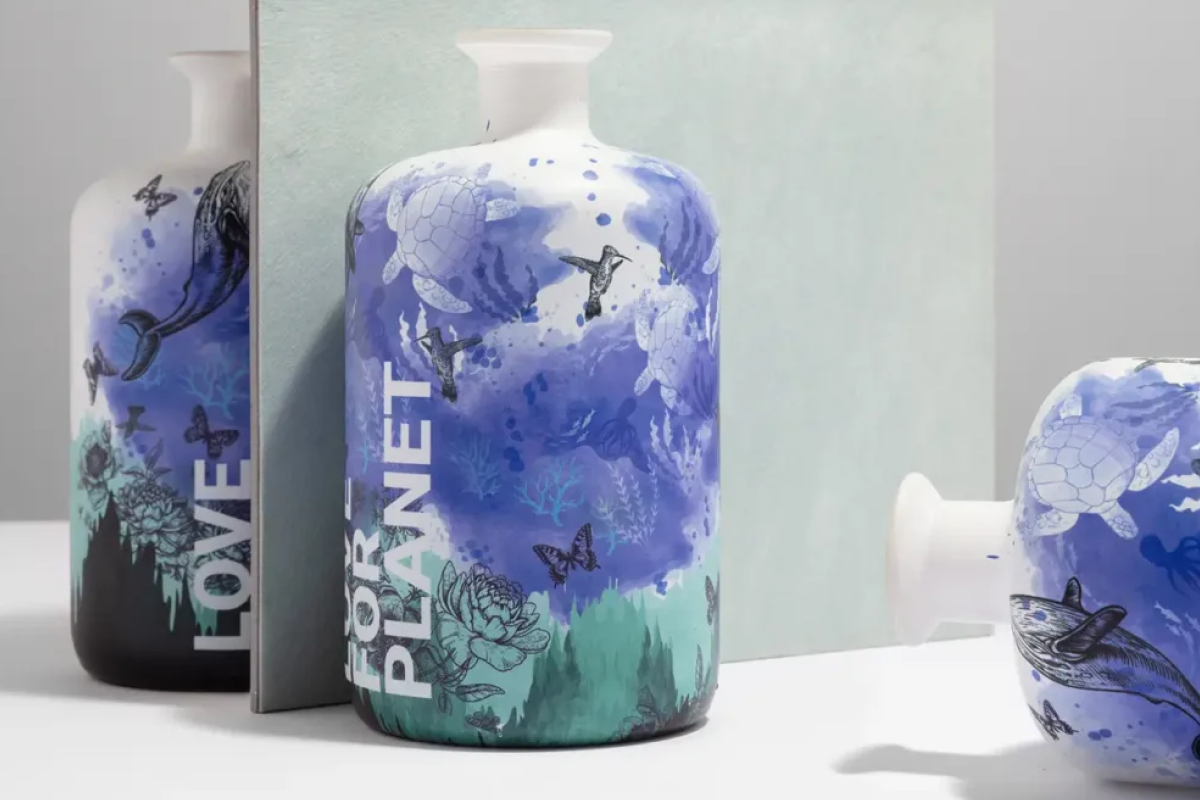The importance of eco-friendly packaging
Eco-friendly packaging is crucial for reducing environmental impact. Sustainable packaging plays a significant role in decreasing waste, conserving resources, and promoting environmental sustainability. Sublimation on glass stands out as a leading method in the eco-friendly packaging revolution, offering vibrant designs while prioritizing environmental stewardship. Glass is highly recyclable and reusable, making it an excellent choice for a more sustainable and greener future.
What is sublimation on glass?
Sublimation on glass is a process where images, text or designs are directly printed onto glass surfaces. This method is eco-friendly as it uses non-toxic inks and does not produce any waste or harmful byproducts. Sublimation on glass creates vibrant and durable designs that are scratch-resistant and can replace the outer boxes or shrink sleeves because of their visual impact.
Advantages of sublimation on glass for packaging
Sublimation on glass for packaging offers several advantages. It provides a durable and environmentally friendly packaging solution, reducing the need for traditional plastic packaging. Glass is also non-toxic and does not leach harmful chemicals, making it a safe option for packaging food and beverages. Additionally, sublimation allows for vibrant and high-quality printing, creating eye-catching designs that stand out on the shelves. Glass is recyclable and reusable, aligning with the growing trend towards sustainability in packaging practices.
The environmental impact of traditional packaging
Traditional packaging has a significant impact on the environment. Plastic packaging is a major contributor to pollution, taking hundreds of years to decompose. Each year, millions of tons of plastic waste end up in landfills and oceans, harming wildlife and ecosystems. Cardboard packaging, although biodegradable, also requires a lot of resources to produce, contributing to deforestation. The excessive use of paper packaging leads to the destruction of forests, affecting biodiversity. Aluminum cans require a substantial amount of energy to produce and recycle, releasing harmful greenhouse gases. Overall, traditional packaging methods have a detrimental effect on the environment, urging the need for sustainable alternatives like sublimation on glass.
How sublimation on glass is revolutionizing the packaging industry
Sublimation on glass is changing how glass packaging is done. This process involves turning solid ink into a gas without it passing through a liquid stage. This unique technique is gaining popularity in the packaging industry due to its eco-friendly benefits and stunning aesthetic appeal. The use of sublimation on glass reduces the need for traditional ink and other harmful materials, making it a more sustainable option.
Examples of brands using sublimation on glass
Brands like Pernod Ricard, Clement Heritier, and Jean Paul Gaultier are embracing sublimation on glass for their packaging. Sublimation allows for vivid colors and intricate designs, making these brands stand out on the shelves. This eco-friendly method is gaining popularity among companies striving for sustainable packaging solutions.
How to incorporate sublimation on glass into your packaging strategy
When incorporating sublimation on glass into your packaging strategy, consider the following:
- Sublimation on glass is a method where designs are permanently infused into the glass surface.
- Benefits:
- Environmentally friendly as it reduces the need for additional packaging materials.
- Creates a high-quality, premium look for your products.
- Steps:
- Choose the right type of material suitable for sublimation (glass, aluminum, ceramic).
- Design your artwork on the whole surface ensuring it is optimized for the sublimation process.
- Use ATIU Technology to transfer the design onto the glass surface.
- Considerations:
- Conduct tests to ensure the durability and quality of your design based on the intended use of your product
- Adapt:
- Customize your packaging design to align with your brand identity while leveraging the features of sublimation on glass to the fullest
Cost considerations and affordability
When considering sublimation on glass for eco-friendly packaging, affordability is a key factor to think about. The cost of this innovative technique can vary based on the size of the glass, the intricacy of the design, and the quantity of items you need. It’s essential to weigh the expenses against the benefits of sustainable packaging to make the most informed decision for your business.
Challenges and limitations of sublimation on glass
Sublimation on glass faces challenges due to its intricate process. The main limitation lies in achieving consistent prints on glass surfaces. Factors like temperature control and printing errors can impact the quality of the final product. Additionally, intricate designs or patterns may pose challenges during the sublimation process. Quality control and Innovative Equipments are crucial to ensure the durability and vibrancy of the print on glass.
The future outlook of eco-friendly packaging and sublimation on glass
Eco-friendly packaging is gaining momentum for a greener planet. Sublimation on glass stands out as a top choice due to its sustainable nature. Glass, being recyclable and reusable, makes it an ideal eco-friendly packaging material. Sublimation, a process that fuses ink into the glass, provides vibrant and long-lasting designs that pose no limits to creativity. This method is not only visually appealing but also environmentally friendly, making it a frontrunner in the eco-friendly packaging revolution.




